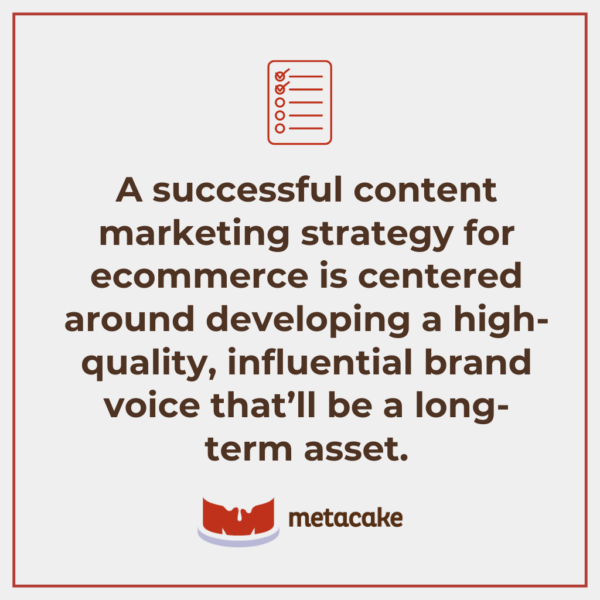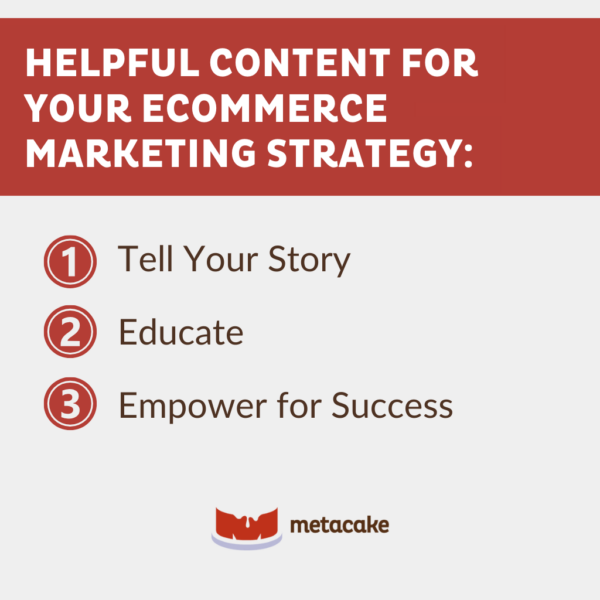
THE ULTIMATE GUIDE TO ECOMMERCE CONTENT MARKETING
Content marketing: It’s one of those catchphrases every marketing guru throws around, but no one really knows what it means. That’s because content marketing for ecommerce can take a variety of forms across different businesses.
Despite a vague definition and a questionable return on investment, content marketing for ecommerce is something marketers will say you “should” be doing. But as an executive or leader of an ecommerce business, you need to know what that entails, what type of budget is required, and what you can expect in return.
In this article, we’re going to talk through what content marketing for ecommerce really is, why it’s valuable, when to use it, and how to put together a simple plan for leading a successful content marketing program.
Everything You’ve Heard About Content Marketing for Ecommerce Is Wrong
You probably have an idea in your head about what content marketing is, and you’re probably already doing some form of it. But if your content marketing plan is writing generic blog posts and posting on social media daily, you’re not going to see any return.
Contrary to what you’ve been told, content marketing isn’t about writing blogs that rank in search engines. It’s not about creating “lead magnets” or making videos for YouTube. Those are all great, but they’re not the point.
To rationalize content marketing for ecommerce, you have to shift your mindset and understand how it’ll give you a return. Rather than thinking about the pieces of content you create, think about the brand voice you’re developing. This may seem small, but it’s a massive shift.
Like your customer email list, a quality brand voice in the marketplace is an asset. It’s something you develop over time, invest in, and use to generate sales. A successful content marketing strategy for ecommerce is centered around developing a high-quality, influential brand voice that’ll be a long-term asset.
Every successful business has a quality, authoritative brand voice, and they use that to influence the market. In order to be bought in on content marketing, you must believe that your brand voice is an asset worth developing. Like any asset it’ll require investment and curation that brings a return in the future.

Stop Doing “Content Marketing”
What does this mean? To execute an effective content marketing strategy, you have to stop thinking of it as content marketing and start thinking of it as your business becoming a media company. You can produce great content that’s informative, aligns with your values, builds your unique brand voice, and entertains your audience. This will never come from writing blog posts stuffed with keywords.
Where Content Marketing Fits in Your Current Ecommerce Strategy
When it comes down to it, marketing falls into two different categories: marketing that has an immediate return on investment and marketing that brings results down the road. Immediate results are important, but if you want to grow, you must be investing in long-term results. And content marketing is one of those long-term wins.
If you’re just starting to think about long-term investments, we recommend starting small. Take 10% of your marketing budget and start investing that into long-term marketing strategies with no expected return. This, like innovation, is an investment you’re placing on your future. Over time, you can grow this to 30%, continuing to increase that percentage the more these long-term efforts start to pay off.
Can Content Marketing for Ecommerce Actually Make Money?
Content marketing involves creating great, consumable content for your customers that grows your relationship and builds your authority. A common misconception many people have is that content marketing only comes in the form of writing blogs or articles. It doesn’t always have to be that way. We have some examples of other types of content marketing further on in this post, but first, let’s be sure we don’t miss the point of content marketing.
When it’s done well, content marketing is a key element in creating emotional connections with your ecommerce customers. Emotion drives a person’s purchase decision, not facts. Connecting with your customers on an emotional level is also what generates raving fans, which is the secret sauce to long-term, stable business growth.
With that in mind, content marketing does, in fact, drive revenue when it’s executed well and with the right mindset.
How to Create an Effective Content Marketing Program for Ecommerce
1. Define Your Brand and Story
Your brand isn’t your product. A brand is the emotional connection you build with your customers through your product and its purpose. If your business is strictly transactional, you’ll make money, but you won’t have loyal customers that come back. True fans only come with a well-developed brand, and your story is a big part of that.
If you’re not sure what your brand’s story is, take time to define the genuine reason your company exists. The more authentic you can make your story, the better. A brand voice can only be developed through content that connects with people.
2. Decide Where to Tell Your Story
Once you have your brand story dialed in, it’s time to tell it. This can be woven throughout your brand’s blog, but it doesn’t have to stop there. In fact, we recommend other places, such as:
- Sections of your site, like your homepage
- Paid advertising for brand awareness or brand education
- Video content on your website or in ads
- Email marketing through welcome sequences or post-purchase sequences
- Blogs, articles, and other written content on your site
3. Produce Helpful Content
You might be tempted to write based on what you think you need to rank well on Google. Don’t do that. SEO has its place, but when you’re thinking about the purpose of content marketing, writing to connect with your customer is more effective than writing for a search engine.

Here are three types of helpful content we recommend including in your content marketing strategy:
A. Tell Your Story
Customers want to know why you created this product. If it’s a story that resonates with them, they’ll buy more. Having a strong “why” behind your business is a competitive advantage.
B. Educate
Educating your market will help you sell more products. Offer information on the primary features and benefits of your products, as well as what makes them unique. Address common objections to eliminate potential customers’ concerns about purchasing. If you’re marketing a new product, make your audience aware of how it works and can benefit them.
C. Empower for Success
Make sure your customers know how to use your products. Even if you sell clothing, there are tips you can share. The point is that the more successful your customers are with your products, the more often they’ll use them, tell others about them, and buy from you again. One of the most effective ways to do this is in post-purchase email sequences.
4. Leverage a Team
Who should be writing all this content? An owner, founder, or someone involved with the core of the brand should be part of it, but they don’t have to be the actual writer. We recommend hiring someone to share your story; provide them with all the tools and background they need, and then let them create the content. Your brand stakeholders can review and provide feedback on the content.
When it comes to things like video, get creative (even if you think your product isn’t very interesting). Here at Metacake, we have a video team dedicated solely to our own video content, where we educate execs and owners on ecommerce principles. That can be kind of boring, so we work really hard to have fun with each video and entertain while we educate.
Pretty soon, there’ll be enough messaging to serve as a central hub of brand-related content. The rest of your team can use this to reiterate more content without the same level of involvement from the stakeholder.
5. Distribute in Priority Order
It’ll take time to distribute your content everywhere it needs to go. We’d recommend working in priority order, as follows:
A. Write Blogs and Articles
Get started with a few cornerstone pieces of content — your brand story, product education, and how to use your products. It’s important to write these first so you can reference and link back to them wherever else you use content marketing.
B. Homepage and Other Areas of Your Site
Sprinkle important content throughout your homepage, collection pages, and product detail pages. Consider incorporating a video or a link to learn more about your brand’s impact on your homepage.
C. Run Advertising
Start running Facebook, YouTube, or other types of advertising that land on your cornerstone content pages. By directing these to new audiences and traffic, these content ads can become a strategic part of your ad funnel. Use these ads to introduce cold traffic to your brand or build trust for site visitors who haven’t purchased yet.
D. Send Emails Promoting the Content
Hopefully you’re already running the three most important automated email sequences: pre-purchase, post-purchase, and abandon cart. If so, incorporate your core content within these emails. This is a great way to tell your story, provide education, and help customers be successful while also seeing an immediate return from it.
E. Create Mailers
Personalize the unboxing experience with a branded postcard highlighting more information about you. A well-designed mailer can be a great place to share your brand’s story, tips for use, or ideas for their next purchase.
F. Produce Videos
Video is one of the best ways to communicate emotion, which is what’ll move visitors and customers to action. Your goal is to create content that makes your customers feel something — it can be excitement over how cool your product is, renewed energy to tackle their workweek, or laughter over something relatable. High-quality video production isn’t cheap, but it can do wonders for your brand — whether you’re posting organically on social media and YouTube or you’re using these videos for ads.
The Ecommerce Executive’s Guide to Content Marketing: Final Thoughts
Content marketing is more than writing blogs or articles and pushing them out to subscribers or cold traffic. The goal is to grow an influential brand voice by defining your brand story, developing content that’ll be helpful for forming relationships with your customers, and distributing that content across a variety of channels.
Leveraging good content in your ecommerce marketing strategy and customer experience is a long-term play, but that doesn’t mean you need to wait around to see results. You can start small, but start today. This is as good a time as any to take advantage of the ways that content marketing can work wonders for your ecommerce brand.
Curious about the best way to get started? Reach out today, and our award-winning team can help you define your first right step.



